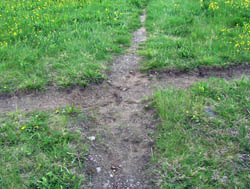Home
> What are elephat paths?
What are elephant paths?
Elephant path is a name for a path that is formed in space by people making their own paths and shortcuts; it is an unofficial route. Elephant path is an anarchist way of moving in a city, a town or a village. It is an overlaying system of going from a place to a place in a space regardless of the city/town plan. Still, it is connected to the streets and the architectural forms.
 It
also reveals something about the people’s social everyday life.
When walking and mapping these paths, you can meet people, document their
aims of using the paths: how often they use them, what is the history
of the path. For example a person can use the same path always when going
to visit his/her grandmother. What kind of memories and motivations this
person might have considering the path?
It
also reveals something about the people’s social everyday life.
When walking and mapping these paths, you can meet people, document their
aims of using the paths: how often they use them, what is the history
of the path. For example a person can use the same path always when going
to visit his/her grandmother. What kind of memories and motivations this
person might have considering the path?
The paths mapped in Elephant Paths -project are not paved and (hopefully) not mapped in any other maps. The name, elephant paths, origins to Karosta, Latvia, where the paths were called by this name.
Definition of a path "officially"
* a course
of conduct; "the path of virtue"; "we went our separate
ways"; "our paths in life led us apart"; "genius usually
follows a revolutionary path"
* a way especially designed for a particular use
* an established line of travel or access
a line or route along which something travels or moves; "the hurricane
demolished housesin its path"; "the track of an animal";
"the course of the river"
From WordNet
2.0 Copyright © 2003 by Princeton University. All rights reserved
Read more at http://www.webster-dictionary.org/definition/path
Desire lines
There is another term that maybe could be the exact translation of elephant path to English. This term is desire line. Desire line is "An informal path that pedestrians prefer to take from one location to other rather than using a sidewalk or other official route".
From The
Word Spy Copyright © 1995 - 2005 Paul McFedries and Logophilia Limited.
Read more at http://wordspy.com/words/desireline.asp
Desire lines is also a term that city planners use when designing pedesterian routes. People naturally want to take a shortest way from one point to another. But if you don't want people using shortcuts, you can disturb they a eye a bit with i.e. plants. From what I've seen I can say that there a still no ways to stop people from creating paths. Even though there are usually not many in very tightly planned city centers, there are always some. And that is great!
| Copyright © 2004 - 2010 Mari Keski-Korsu |